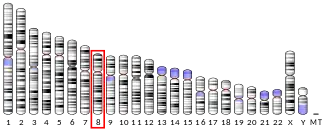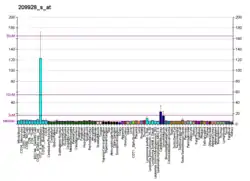Musculin is a protein that in humans is encoded by the MSC gene.[5][6][7]
The protein encoded by this gene is a transcriptional repressor capable of binding an E-box element either as a homodimer or as a heterodimer with E2A in vitro. The encoded protein also forms heterodimers with E2A proteins in vivo. This protein is capable of inhibiting the transactivation capability of E47, an E2A protein, in mammalian cells. This gene is a downstream target of the B-cell receptor signal transduction pathway.[7]
References
- 1 2 3 GRCh38: Ensembl release 89: ENSG00000178860 - Ensembl, May 2017
- 1 2 3 GRCm38: Ensembl release 89: ENSMUSG00000025930 - Ensembl, May 2017
- ↑ "Human PubMed Reference:". National Center for Biotechnology Information, U.S. National Library of Medicine.
- ↑ "Mouse PubMed Reference:". National Center for Biotechnology Information, U.S. National Library of Medicine.
- ↑ Massari ME, Rivera RR, Voland JR, Quong MW, Breit TM, van Dongen JJ, de Smit O, Murre C (Jun 1998). "Characterization of ABF-1, a Novel Basic Helix-Loop-Helix Transcription Factor Expressed in Activated B Lymphocytes". Mol Cell Biol. 18 (6): 3130–9. doi:10.1128/mcb.18.6.3130. PMC 108895. PMID 9584154.
- ↑ Robb L, Brodnicki T, Copeland NG, Gilbert DJ, Jenkins NA, Harvey RP (May 1999). "Assignment of the human helix-loop-helix transcription factor gene musculin/activated B-cell factor-1 (MSC) to chromosome 8q21 and its mouse homologue (Msc) to the proximal region of chromosome 1". Genomics. 57 (2): 318–9. doi:10.1006/geno.1999.5764. PMID 10198176.
- 1 2 "Entrez Gene: MSC musculin (activated B-cell factor-1)".
Further reading
- Bonaldo MF, Lennon G, Soares MB (1997). "Normalization and subtraction: two approaches to facilitate gene discovery". Genome Res. 6 (9): 791–806. doi:10.1101/gr.6.9.791. PMID 8889548.
- Robb L, Hartley L, Wang CC, et al. (1998). "musculin: a murine basic helix-loop-helix transcription factor gene expressed in embryonic skeletal muscle". Mech. Dev. 76 (1–2): 197–201. doi:10.1016/S0925-4773(98)00122-1. PMID 9767165. S2CID 780834.
- Wong J, Funes-Duran M, Ahlberg J, et al. (2001). "Characterization of a basic helix-loop-helix protein, ABF-1: nuclear localization, transcriptional properties, and interaction with Id-2". DNA Cell Biol. 20 (8): 465–71. doi:10.1089/104454901316976091. PMID 11560778.
- Strausberg RL, Feingold EA, Grouse LH, et al. (2003). "Generation and initial analysis of more than 15,000 full-length human and mouse cDNA sequences". Proc. Natl. Acad. Sci. U.S.A. 99 (26): 16899–903. Bibcode:2002PNAS...9916899M. doi:10.1073/pnas.242603899. PMC 139241. PMID 12477932.
- Knight JC, Keating BJ, Kwiatkowski DP (2004). "Allele-specific repression of lymphotoxin-alpha by activated B cell factor-1". Nat. Genet. 36 (4): 394–9. doi:10.1038/ng1331. PMID 15052269.
- Gerhard DS, Wagner L, Feingold EA, et al. (2004). "The Status, Quality, and Expansion of the NIH Full-Length cDNA Project: The Mammalian Gene Collection (MGC)". Genome Res. 14 (10B): 2121–7. doi:10.1101/gr.2596504. PMC 528928. PMID 15489334.
- Rual JF, Venkatesan K, Hao T, et al. (2005). "Towards a proteome-scale map of the human protein-protein interaction network". Nature. 437 (7062): 1173–8. Bibcode:2005Natur.437.1173R. doi:10.1038/nature04209. PMID 16189514. S2CID 4427026.
- Kimura K, Wakamatsu A, Suzuki Y, et al. (2006). "Diversification of transcriptional modulation: Large-scale identification and characterization of putative alternative promoters of human genes". Genome Res. 16 (1): 55–65. doi:10.1101/gr.4039406. PMC 1356129. PMID 16344560.
This article is issued from Wikipedia. The text is licensed under Creative Commons - Attribution - Sharealike. Additional terms may apply for the media files.




